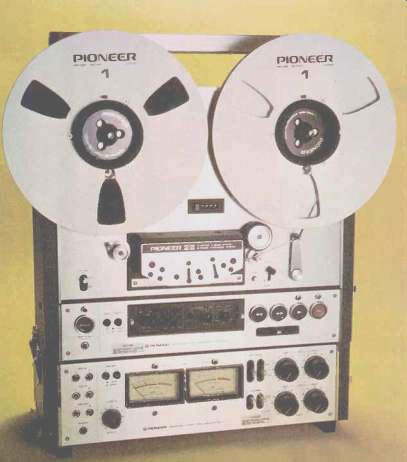
MANUFACTURER'S SPECIFICATIONS
Frequency Response: 30 Hz to 28 kHz @ 15 ips, 40 Hz to 20 kHz @ 7 1/2 ips.
Harmonic Distortion: 0.8 percent @ 15 ips, 1.0 percent @ 7 1/2 ips.
S/N Ratio: 57 dB at +6 dB level.
Separation: 53 dB.
Input Sensitivity: Mike, 0.11 mV; Line, 34 mV @ 100 kilohms.
Output Level: Line, 450 mV at reference flux level, 930 mV maximum; Headphones, 133 mV maximum.
Wow & Flutter: 0.04 W rms @ 15 ips, 0.08 W rms @ 7 1/2 ips.
Speed Deviation: 0.8 percent.
FF & RWD Times: 110 seconds for 2,400 feet.
Dimensions: Transport, 18 1/8 in. (46 cm) W x 16 3/16 in. (41.1 cm) H x 10 13/16 in. (27.4 cm) D. Amplifier, 18 1/8 in. (46 cm) W x 5 9/16 in. (14.1 cm) H x 10 13/16 in. (27.4 cm) D.
Weight: Transport, 51.2 lbs. (23.2 kg).
Amplifier, 11.3 lbs. (5.2 kg).
Price: $1250.00.
The well -performing Pioneer RT -2022 system tape deck is comprised of two sections, the RTU-11 transport unit and the TAU -11 amplifier unit. The transport operates at 7 1/2 and 15 ips and takes up to 101/2 -inch reels. The head assembly provides direct access to record and playback head adjustments and to all surfaces requiring cleaning and demagnetization. To the left are the guide roller arm and the pause switch, and above is the tape counter. The tape is metered out of the head assembly by the capstan with the pinch roller on the oxide side, with drive applied to the back of the tape, as is the case with a number of professional units. The tension arm, which guides the tape to the take-up reel, incorporates a switch controlling power to all motors.
The cue lever can be used to vary the amount of signal pickup by the playback head, even in fast winds. A pushbutton lock facilitates locating exact edit points.
In the center of the lower portion of the transport unit are provisions for several adjustments, under an easily -removed, clear -plastic cover. The test oscillator switch positions are Off, 1 kHz, and 10 kHz. Bias has a fixed position plus separate Low and High ranges with a variable pot. EQ can be set for either NAB or IEC and to match Std (standard) or LH (low -noise) tapes. Setting the best bias for a tape is worthwhile for any class of machine, and the two -frequency oscillator provides a quick and simple means to check and peak up performance. Inclusion of these features must be considered a big plus for this deck. To the left are switches for power, reel size, and tape speed, a power indicator lamp, and a phone jack for feeding the output of the test oscillator externally. The logic-controlled tape -motion switches on the right are large pushbuttons with status lights for Play and Record. Stop is controlled with a long bar. These functions are all repeated on the optional remote control unit, received with the deck. The control also includes a pause button and a Ready lamp, which will not be On unless tape is threaded and holding the tension arm in play position, a desirable feature. The carry handle on top is quite commendable, as is the latch -on front cover. All too many high-performance decks are difficult to carry to a remote site.
Interconnection between the transport and amplifier units is made with a 12 -pin plug/cable assembly and three sets of stereo color- and letter-coded phono cables, one set for the record head output for sync recording, an important feature for anyone who may need to over -dub. The phono jacks for line in and out are all paralleled, aiding system hookups. The front of the unit is where all of the action is, however, with attention drawn to the good-sized, well -illuminated level meters which cover a wide range from -40 to +6 dB. There are zero adjustment screws below and record indicators above. At the left are phone jacks for mike, line in and out, and headphones. These line jacks can be used in place of the back panel ones, which are disconnected with plug insertion. Mike attenuator switches introduce a 20 -dB loss when needed because of high mike levels. The output level control is detented half -way, at which point the output from a tape flux level of 185 nanoWebers/meter should be at meter zero. There is also a knurled marker ring, and the pot sections are friction clutched to allow setting channel levels individually or simultaneously as desired, all good features. The mike and line inputs were easily mixed, and the pots have good-sized knobs and handy marker rings. The channel monitor switches can select either tape or source, and the record -mode selectors can be set for record, play, or sync play/recording.
On top is a cable -storage compartment and a carrying handle. Hooks and latches mate with a front cover and the transport unit, when it is placed on top.
Access to the interiors of the units was obtained with removal of back and bottom metal covers. Soldering was very good, with wire wrap used for many of the off -board connections. Drive and braking systems were judged to be reasonably rugged. The hysteresis synchronous motor belt drives the capstan with its impressively-large flywheel.

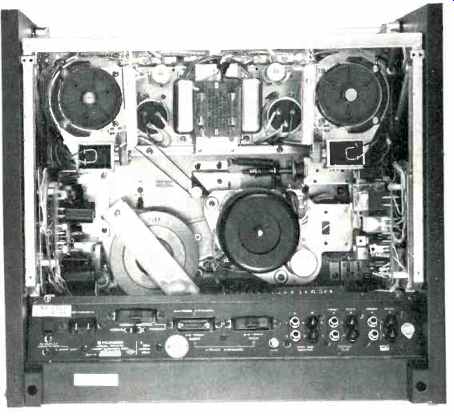
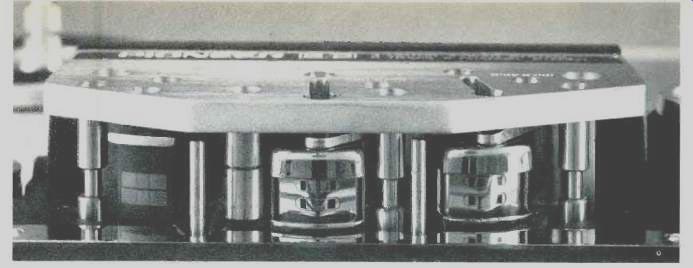
Performance
Playback responses were within 3 dB at all test frequencies for both speeds, 7 1/2 and 15 ips. Selection of tape formulations to be used for testing was made with the use of a pink -noise source and a third -octave real-time analyzer on playback. NAB/LH EQ was used for all of the tests, but it should be noted the IEC EQ can gain better S/N ratios at 15 ips. Bias was varied over both ranges (- 40 to -8 percent and -15 to +38 percent, relative to fixed) as well as trying the fixed setting. The built-in test oscillator was evaluated for use in making the same adjustments, using both the 1and 10 -kHz tones, and then checking the pink -noise response.
The scheme worked very well, and its inclusion must be given a big plus rating for the deck. Most low-noise tapes could be matched for excellent responses, and Maxell UD, Memorex Quantum, Scotch 206, and TDK Audua were selected for further tests. Scotch 150 did surprisingly well for a discontinued tape, so some swept responses were run just to check what the adjustments could do. The swept -frequency responses for Scotch 206 were run at 0, +10 and -10 VU at 15 ips, and at 0 VU at 7 1 ips, using the recommended fixed bias. The excellent headroom was amply demonstrated by the fact that the responses extended from about 30 Hz to 22 kHz or more at all three levels at 15 ips. As received, the high -frequency response, however, did not quite reach the specified 28 kHz, and at 7 1/2 ips the 0 VU headroom limit dropped to 14 kHz. Using variable bias, improvements were easily made, increasing the high -end limits to match the specifications. TDK Audua was used to measure the effect of varying bias in High from minimum to maximum in three steps. The plots clearly showed the reduction in highs with the first change, and then the level loss across the entire frequency range with maximum bias. With the medium -high bias, there was a small rise around 7 kHz, and the response extended to over 30 kHz at 0 VU, excellent performance.
The Scotch 150 gave its best results with minimum -low bias, with a response from 23 Hz to 21.5 kHz at -10 VU and 7 1/2 ips.
For those who would want to over-dub on one channel in sync with the other, the RT -2022 offers the essential play back capability from the record head. The 15-ips record/playback response was generally flat with a slight peak around 6 kHz and a rapid roll-off above 8 kHz. As would be expected, the sound had extra presence. The playback level was quite high, which would also be helpful for the feed to the performer.
The function of third-order harmonic distortion (HDL3) versus record level was measured with a 1 -kHz tone from -8 to + 10 VU with Scotch 206 at both 7 1 and 15 ips. The results for both speeds were quite similar, with HDL3 = 0.27 percent at 0 VU and 2 percent or less at +10 VU, excellent performance. Spot checks were made with other tapes, which gave about the same results. HDL3 was also measured over a range of frequencies from 30 Hz up for 15 ips at 0 and -10 VU and for 7 1/2 ips at -10 VU only. There was the expected rise in relative distortion at the lowest frequencies, but the rapid drop in distortion products above 1 kHz was a surprise. Bias was not excessive, according to the wide frequency response, but the harmonics dropped below the measurement limit of the spectrum analyzer. It does appear that some of this superb performance at the high end could be given up in trade for a reduction of HDL3 at the low end.
A fast check was given to the built-in test oscillator for level and distortion. The output was 350 mV, and all distortion products for both 1kHz (1064 Hz actual) and 10 kHz (10,859 Hz actual) were less than 1 percent of the fundamental. The distortion level was low enough for setting bias when checking frequency response, but would not be satisfactory for adjusting bias for minimum distortion.
The RT-2022 showed excellent signal-to-noise ratio with close to 58 dBA at 15 ips and over 59 dBA at 7 1/2 ips, both at meter zero. With a HDL3 = 2 percent reference, the figures become 67.8 dBA at 15 ips and 72.9 dBA at 7 1/2 ips, both for Scotch 206. The separation between channels was 58 dB, and erase was at least 80 dB down, both excellent. Input sensitivities were 0.1 mV for mike and 44 mV for line, a good figure though a bit above the specified 34 mV. The line output level was a maximum of 1.06 V +6 on the meter, with 0 VU record, greater than the specified 930 mV. With the output pot at the reference detent, however, the output voltage was lower than specified with a meter indication of about -4 dB for playback of either an Ampex test tape or Scotch 206 with 0 VU record. Drive to the headphones was a maximum of 185 mV. The meter frequency response was down 3 dB at 23 Hz and 53 kHz. Indications were within 0.2 dB over the entire range from -40 to + 6 dB, just plain excellent. The dynamic response of the meter was faster than a standard VU meter, swinging to +3 dB with the test 300-millisecond burst, and to zero with an 80-mS burst. The meter would be classified as a fast -response meter, but the overshoot was undesirable, and the decay seemed too rapid for easy use.
The average wow and flutter figures were 0.038 percent
Wtd peak for 15 ips and 0.072 percent
Wtd peak for 7 1/2 ips.
This was good performance, and actually well within the specified 0.04 percent and 0.08 percent which are on a weighted rms basis. Long-term speed accuracy was excellent with only a very slight shift when the line voltage was varied.
The peak-to-peak speed variations were less than 0.05 percent at 15 ips, but increased notably at 7 1/2 ips to about 0.25 percent. The sound levels at one foot were 33 dBA for 7 1/2 ips and 39 dBA for 15 ips, perhaps a little high for recording in a quiet environment. The wind times were quite fast, just 62 seconds for a 1200 -foot, 7 -inch reel and 115 seconds for a 2400 -foot, 10 1 -inch reel. It was a mixed blessing, however, as shut-off of the drive power on run -out was too slow and there was a flailing of the tape until the tension arm switch actuated.
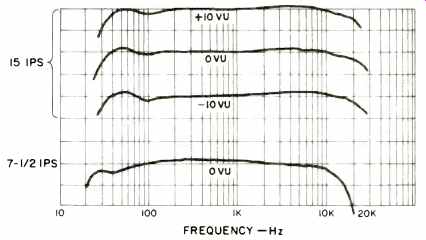
Fig. 1 Record/playback response with equalization at the NAB low-noise setting
with Scotch 206 tape and fixed bias. There are three readings at 15 ips, 10,
0 and -10 VU, but only 0 VU (0) 7 1/2 ips.
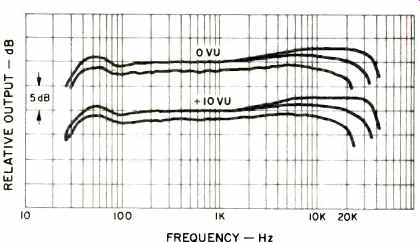
Fig. 2 Record/playback response with TDK Audua tape with the equalization
at the NAB low -noise setting and the high bias set for minimum on the top
trace, medium for the middle trace, and maximum on the bottom trace with readings
at both 0 and -10 VU.
In-Use Tests
The lock on the guide -roller arm was helpful in threading the tape, but the tension arm was typical in fighting the process a little. All combinations of tape motion switching were handled without any form of difficulty, including going to play from one of the fast winds. This took about one second for the unit to come to a stop and another five seconds to go into play. The instruction book states how to use Pause to reduce the amount of delay, but such an extra step should not be necessary. The rubber lock plug for use with the Record and Play buttons and the timer start worked fine, but the plug fought the process of insertion. The delay in turnoff of the drive power at the end of play or wind and the resultant spinning of the reels got to be an annoyance. Using wind of the opposite direction and Stop to get to the end of the tape smoothly was a rather fussy operation. As both 7 and 10 1/2-inch reels were used in the course of the testing, an attempt was made to reverse the reel bases as recommended, to provide the correct spacing for the respective' reels. It was so difficult, however, to remove the bases from the annular retaining grooves that they were not used for their intended purpose. After the above comments on the fussing about mechanical things, I hasten to add that the pot knobs and marker rings were all of very good design and that the action of the pots themselves was very smooth. The wide-range meters were very easy to use for setting record levels, with the exception that the decay time was a little short, and some form of peak indication would have been helpful.

Fig. 3-Third harmonic distortion vs. record level with Scotch 206 tape, the
results from other tapes are quite similar. The HDL3 is specified as 0.8 percent
@ 15 ips and 1.0 percent at 7 1/2 ips at 0 VU. There was some second and fifth
harmonic distortion at the higher levels which measured 0.1 percent or less
at 10 VU (lower @ 7 1/2 ips) and it was less at lower record levels.
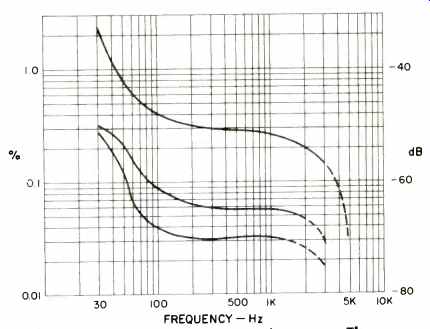
Fig. 4 Third harmonic distortion vs. frequency. The top trace is 0 VU @ 15
ips, the middle trace is -10 VU @ 7 1/2 ips, and the bottom trace is -10 VU
@ 15 ips.
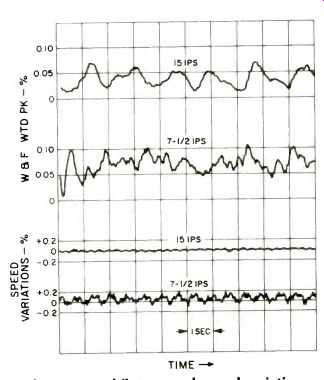
Fig. 5 The wow and flutter and speed variations of the Pioneer RT-2022 deck.
The top traces show wow and flutter at 15 and 7 2 ips, while the lower traces
show the speed variations at both 15 and 7 1/2 ips.
Different types of sources were recorded, and switching from source to tape during the process revealed no modification to the sound in playback. The instruction book is very good with considerable detail in the text and coupled with excellent illustrations. It did seem a little odd, however, to see scissors shown for use in splicing tape. Detailed schematics are provided of both the transport and the amplifier units. Among the accessories were head -cleaning supplies and phone -plug cables for front -panel patching for over dubbing.
The Pioneer RT-2022 system tape deck, in general, has excellent performance. For the person who might change from tape to tape at times, the bias and EQ adjustments, in conjunction with the two -frequency test oscillator, are a very valuable combination, ensuring maximum system performance. For the sophisticated audiophile or the neophyte professional, the limitations in the area of tape handling could very well be more than compensated for by the availability of simultaneous sync and the ease of changing to four -channel operation, not to mention price.
-Howard A. Roberson
(Source: Audio magazine, Sept. 1977)
Also see:
Pioneer CT-9R cassette deck (ad, Sept. 1981)
Pioneer electronics (ad, May 1974)
Pioneer electronics "State-of-the-Art" (ad, Aug. 1981)
Pioneer PL-510 turntable (ad, May 1977)
= = = =